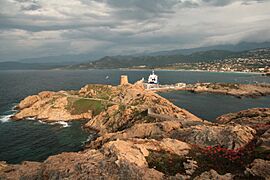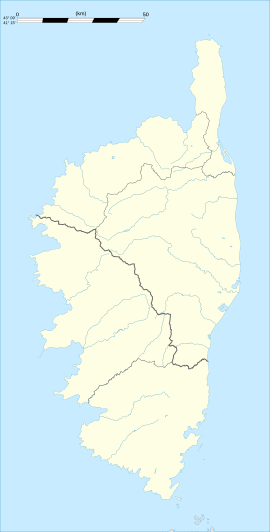L'Île-Rousse facts for kids
Quick facts for kids
L'Île-Rousse
Lìsula
|
||
|---|---|---|

Port
|
||
|
||
| Country | France | |
| Region | Corsica | |
| Department | Haute-Corse | |
| Arrondissement | Calvi | |
| Canton | L'Île-Rousse | |
| Intercommunality | CC de l'Île-Rousse - Balagne | |
| Area
1
|
2.5 km2 (1.0 sq mi) | |
| Population
(2021)
|
3,220 | |
| • Density | 1,288/km2 (3,340/sq mi) | |
| Time zone | UTC+01:00 (CET) | |
| • Summer (DST) | UTC+02:00 (CEST) | |
| INSEE/Postal code |
2B134 /20220
|
|
| Elevation | 0–151 m (0–495 ft) (avg. 15 m or 49 ft) |
|
| 1 French Land Register data, which excludes lakes, ponds, glaciers > 1 km2 (0.386 sq mi or 247 acres) and river estuaries. | ||
L'Île-Rousse is a town in France, located on the island of Corsica. Its name means "Red Island" because of the reddish rocks near its harbor. In the local Corsican language, it's called Lìsula or Isula Rossa.
This town was started in 1758 by Pasquale Paoli. He wanted a port that was not controlled by the Genoese, who ruled parts of Corsica. Before 1848, the official language of Corsica was Italian. So, the town was first named Isola Rossa.
L'Île-Rousse is one of only three towns in its area with a French name. Most other towns in Corsica still use their Italian names.
Contents
History of L'Île-Rousse
L'Île-Rousse has been lived in for a very long time. People lived here between 5000 and 3000 BC. Around 1000 BC, it was a busy town called Agilla. This town was connected to Tyre in Phoenicia.
Later, Agilla was destroyed. It then became part of the Roman Empire and was called Rubico Rocega. This name also means "red rock." The Romans ruled until the 4th century AD.
Because it was so close to the sea, the town was often in danger from pirates. For many centuries, only fishermen and farmers lived there. They lived off the sea and land around nearby villages like Santa Reparata and Monticello.
Founding the Port
In the 17th century, traders from Santa-Reparata-di-Balagna set up shops here. They traded by sea with other coastal villages.
Around 1759, Pasquale Paoli decided Corsica needed a new port. He wanted a port in the northwest to stop sea traffic between Genoa and Calvi.
On December 10, 1765, Paoli got permission to build a fort to protect the port. This decision led to the creation of L'Île-Rousse.
Climate and Weather
L'Île-Rousse has a hot-summer mediterranean climate. This means it has hot, dry summers and mild, wet winters.
The average temperature each year is about 16.9 degrees Celsius. The town gets about 473.8 millimeters of rain per year. November is usually the wettest month.
The hottest month is August, with an average temperature of about 24.9 degrees Celsius. February is the coldest, averaging about 10.4 degrees Celsius.
The highest temperature ever recorded was 39.6 degrees Celsius on July 5, 1993. The coldest was -1.3 degrees Celsius on December 28, 1996.
| Climate data for L'Île-Rousse (1991–2020 averages, extremes 1988–present) | |||||||||||||
|---|---|---|---|---|---|---|---|---|---|---|---|---|---|
| Month | Jan | Feb | Mar | Apr | May | Jun | Jul | Aug | Sep | Oct | Nov | Dec | Year |
| Record high °C (°F) | 20.8 (69.4) |
22.2 (72.0) |
27.9 (82.2) |
29.3 (84.7) |
32.2 (90.0) |
36.7 (98.1) |
39.6 (103.3) |
36.9 (98.4) |
35.2 (95.4) |
31.3 (88.3) |
25.9 (78.6) |
25.2 (77.4) |
39.6 (103.3) |
| Mean daily maximum °C (°F) | 12.8 (55.0) |
12.9 (55.2) |
14.9 (58.8) |
17.4 (63.3) |
21.2 (70.2) |
25.0 (77.0) |
27.6 (81.7) |
27.9 (82.2) |
24.6 (76.3) |
21.1 (70.0) |
16.9 (62.4) |
13.9 (57.0) |
19.7 (67.5) |
| Daily mean °C (°F) | 10.6 (51.1) |
10.4 (50.7) |
12.2 (54.0) |
14.5 (58.1) |
18.1 (64.6) |
21.8 (71.2) |
24.5 (76.1) |
24.9 (76.8) |
21.7 (71.1) |
18.5 (65.3) |
14.5 (58.1) |
11.7 (53.1) |
16.9 (62.4) |
| Mean daily minimum °C (°F) | 8.4 (47.1) |
7.9 (46.2) |
9.5 (49.1) |
11.5 (52.7) |
15.0 (59.0) |
18.6 (65.5) |
21.4 (70.5) |
21.9 (71.4) |
18.8 (65.8) |
15.9 (60.6) |
12.2 (54.0) |
9.5 (49.1) |
14.2 (57.6) |
| Record low °C (°F) | −1.0 (30.2) |
−0.9 (30.4) |
−1.1 (30.0) |
2.5 (36.5) |
5.6 (42.1) |
9.1 (48.4) |
13.0 (55.4) |
14.8 (58.6) |
10.8 (51.4) |
4.7 (40.5) |
1.1 (34.0) |
−1.3 (29.7) |
−1.3 (29.7) |
| Average precipitation mm (inches) | 34.0 (1.34) |
32.7 (1.29) |
42.9 (1.69) |
39.9 (1.57) |
30.2 (1.19) |
29.8 (1.17) |
7.1 (0.28) |
13.5 (0.53) |
43.7 (1.72) |
60.6 (2.39) |
85.5 (3.37) |
53.9 (2.12) |
473.8 (18.65) |
| Average precipitation days (≥ 1.0 mm) | 5.6 | 5.5 | 5.8 | 5.9 | 4.3 | 2.9 | 0.8 | 1.4 | 4.7 | 6.5 | 8.5 | 6.3 | 58.2 |
| Source: Meteo France | |||||||||||||
Exploring L'Île-Rousse
L'Île-Rousse is built on a beautiful bay. To the northwest, you can see rocky islets with a reddish color. These rocks give the town its name. To the south, there is a lovely white sand beach.
The town stretches from the sea towards a hill called the Sémaphore. It offers great views to visitors.
Old Town Charm
The old part of L'Île-Rousse was planned by Pasquale Paoli. He is known as "the Father of the Fatherland." The streets are mostly straight and paved.
The town grew around its port and market. The market has 21 columns. The old city also has fortifications and historic houses. These were built from 1765 to the mid-1800s.
Some houses have special Florentine staircases inside. The first church, built in 1740, was called Notre-Dame. The current church, Notre Dame de Miséricorde, is next to an old Franciscan convent.
The main church, the Immaculée Conception de Marie, is on the west side of the main square. This square has huge date palms planted in 1890. It's a great spot to play pétanque, a popular French game.
Modern and Historic Blends
The newer parts of town fit well with the old. They meet at Place Paoli, a square shaded by old plane trees. It's a nice place to relax in the summer.
The old town invites visitors to walk on its historic paved streets. Many streets are named after important figures like Pasquale Paoli and Napoleon.
L'Île-Rousse has a rich history. It was founded by Pasquale Paoli. After 1815, it even had a blazon (coat of arms) with the royal fleur-de-lis of France. This mix of history makes it a unique and interesting place for tourists.
Population Changes
The number of people living in L'Île-Rousse has changed over the years. Here's how the population has grown and shrunk:
| Historical population | ||
|---|---|---|
| Year | Pop. | ±% p.a. |
| 1968 | 2,036 | — |
| 1975 | 2,360 | +2.13% |
| 1982 | 2,632 | +1.57% |
| 1990 | 2,288 | −1.74% |
| 1999 | 2,774 | +2.16% |
| 2007 | 2,765 | −0.04% |
| 2012 | 3,740 | +6.23% |
| 2017 | 3,043 | −4.04% |
| Source: INSEE | ||
Famous People
- Pasquale Paoli - The founder of L'Île-Rousse and a Corsican leader.
- Battista Acquaviva
Images for kids
-
Bust of Pasquale Paoli
See also
 In Spanish: L'Île-Rousse para niños
In Spanish: L'Île-Rousse para niños







